| Example
Pictures |
Characteristics |
|
|
|
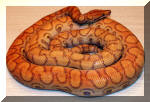 |
Lockwood (EBV) Hypo
- Proven recessive
The animals are very noticeably lighter in
color and the typical black areas are light to chocolate brown
in color. The original hypos were produced in 1994 from a pair
of siblings that were bred together and subsequently sold to EBV.
|
|
(pic needed) |
Darin Bell (DB) Hypo
- Proven Recessive
(writeup needed) |
|
(pic needed) |
European Hypo
(writeup needed) |
 |
Sharp Anery - Proven Recessive
Originally produced by Brian Sharp, the babies are silver
and taupe. As adults they are mostly brown with white
crescents. |
|
(pic needed) |
Seib Anery - Mode of inheritance unknown
Originally produced by Robert Seib, it was originally
thought to be recessive. Mike Lockwood bred his Hypos
to two Anery females to produce "double Het Ghost" babies.
When those babies were eventually bred, there were four
litters produced with 80 total babies, 20 Hypos and two odd
"Ghosts" but no visual Aneries. This event places the
Seib line mode of inheritance into question. More work
TBD. |

 |
Outback Albino (T-)
- Proven Recessive
White and orange with no dark pigment is typical to t
negative albinos.
Wild caught adult male visual acquired by Outback reptiles
in yyyy? Was in rough shape and took them several
years to recuperate and acclimate to captivity before they
could produce the first litters of hets. Visual
Albinos first produced by them in 2014. |
 |
Caramel Albino (T+)
- Proven Recessive
Caramel colored with Dark eyes is typical to t positive
Albinos.
(History needed) |

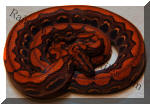 |
Candy Stripe
- Incomplete Dominant
Heterozygous expression ( Candy Stripe) is dorsal striping
with intense coloration.
Homozygous expression (Super Candy Stripe) is full body
striping with dark head, pink tongue and split frontal
scale.
Discovered by Dave Colling in 2011 by breeding siblings
with dorsal connected patterns. To date original pair
has been bred twice with approximately 1/4 of each litter
Supers, 1/2 Candys and 1/4 normals. The male has also
been bred to two unrelated females with some Candy stripes
and some normals produced. F3 Super Candy and Candy stripes
were produced in 2019 |

 |
Zebra Pearl Stripe
- Incomplete Dominant
Found within my Pearl animals but seems to be related to
only a few of them.
Zebra Stripe is defined as connections between dorsal and
lateral patterns and is quantified by number of connections
"Z-xx"
Heterozygous expression seems to be in the 1 to 10 connected
spot range.
Homozygous expression seems to be in the 35 plus range.
|


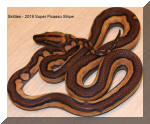 |
Picasso Stripe
- Incomplete Dominant
More of an Aberrant pattern morph. Single gene expression is
odd shaped patterns both dorsal and lateral. Double
gene expression is significantly greater number of aberrant
patterns with some blending into stripes. The most
extreme Supers have near or even complete body striping.
|
(better pic needed)
 |
Ted Thompson Stripe
- Proven Recessive
From Susquehanna Ectotherms.
(Additional details TBD) |
 |
Wipeout (reduced Dorsal
Pattern) - Partially
Proven Incomplete Dominant
Heterozygous expression - Some hints of reduced dorsal
pattern and/or some dorsal patterns reduced to only a black
dot.
Homozygous expression - much of the dorsal pattern either
totally missing or in some cases reduced to dark spots.
Discovered by Aubry Ross in yyyy?
(additional details needed) |
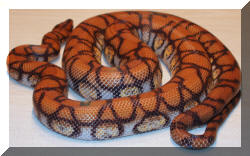 |
Pearl
- suspected recessive
A pattern morph where the side crescent patterns are so
exaggerated they are completely crescent colored, no black.
|

 |
Pinstripe
- Mode TBD
Orignially produced by Nic Garofalo the Pinstripes are
characterized by dorsal patterns connected together with a
fine dark outline. These connected patterns often have
almost straight edges, not just multiple spots merged
together in a zig zag type pattern. Some are only a few
dorsal spots while others are near full body stripes. |
|
(pic needed) |
Eugene Stripe
- ????
(story needed) |
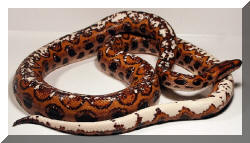 |
Calico
- Mode of inheritance TBD
A pattern morph where areas are turning
white. I took this project over from Brian Sharp. According to Brian, he was originally
sold as a normal in CA. At two or three years of age,
he shed off areas of color and has been that way ever since.
I produced three litters of offspring in 2008/2009 a,d a
litter of F2's in 2012. I'm raising up the entire
litter of F2's to see what happens. fingers crossed!
|
|
(pic needed) |
Leopard
- ????
(story needed) |
|
|
|
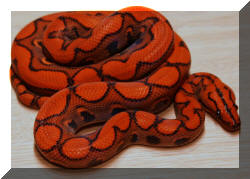 |
High
Orange
BRB's specifically bred for the brightest of orange
colors.
|
 |
High Red
Similar to High Orange but bred for
bright red colors.
|
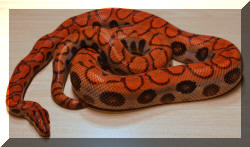 |
Eclipse
A pattern morph where the side crescents
are completely missing. Sometimes leaving a light
blush in the middle of the side medalions. Has shown
up in a few babies descended from Savannah, an adult I
acquired in 2004. Working to see if this is genetic
and can produce more.
|
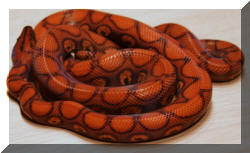 |
Bull's
Eye
A pattern morph where the side crescent patterns are so
exaggerated they will sometimes form complete circles. These
are still in development and at this time have some side
patterns complete. My current first generation breeding trials
show this trait is most likely polygenic or not specifically
tied to one gene but is definitely passed on from parent to
offspring in a varying degree. The babies range from less
crescent to much more crescent. As I breed this trait through
the next few generations I expect this to continue where the
babies are plus and minus the parents. As the parents approach
fuller Bull's Eyes, the babies should get better and better.
Future plans include breeding this pattern morph into all of
my color lines
|
 |
Normal
As if that can be said for a BRB, they all show amazing
colors and patterns along with the rainbow iridescence that is
typical to the species. All my breeders are being selected for
specific traits and the babies are getting better and better
with each
generation.
|